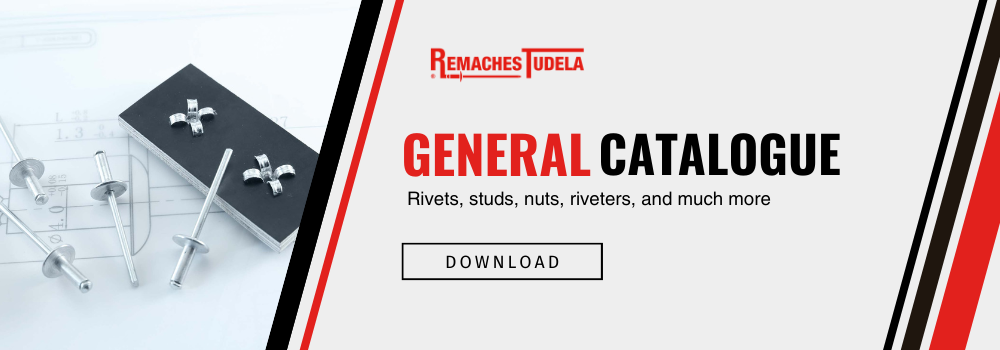In the world of construction and industry, riveting machines are essential tools that play a fundamental role in securely and durably joining materials. If you want to learn more about riveting machines, don’t miss this post on the Remaches Tudela blog, where we explain what a riveting machine is, what it’s used for, and the different types of riveting machines available on the market.
What is a riveting machine
A riveting machine is a tool specifically designed to join two pieces of material using rivets or rivetable products. Rivets are fastening elements consisting of a cylindrical shaft and a body at one end. The riveting machine is used to apply or rivet a product, securely and permanently joining two pieces of metal or plastic, creating strong and resistant joints. This technique has been used for centuries and has proven to be a reliable and durable way to join materials.
Riveting machines consist of several key parts, including a handle for holding the tool, a nozzle that holds the rivet in place, and a tightening mechanism that applies the necessary force to deform the rivet. Depending on the type of riveting machine, this force can be generated in different ways, such as by manual application, pneumatic power, or even battery operation.

What is a riveting machine used for
Now that we know what a riveting machine is, it’s important to understand what this tool is used for and why it is so valuable in various industries. Riveting machines are primarily used to achieve solid and permanent joints in applications where high mechanical strength is required. Below are some of the main applications of riveting machines:
Material joining
The primary purpose of a riveting machine is to permanently join materials. This is especially useful in situations where a strong and durable connection is required that cannot be easily dismantled. Some common examples of applications include:
- Construction
In construction, riveting machines are used to join metal structures such as beams and profiles. This ensures that the connections are solid and secure, which is essential for the structural integrity of buildings. - Automotive industry
In vehicle manufacturing, riveting machines are used to assemble car bodies and metal components. This ensures that automobiles are safe and robust. - Aerospace industry
In the aerospace industry, where safety and strength are critical, riveting machines are used to join parts of airplanes and spacecraft.
Repairs and maintenance
Riveting machines are also useful for repairs and maintenance tasks. They can be used to replace damaged or worn rivets in a variety of applications, from repairing metal roofs to restoring old structures.
Industrial applications
In industrial settings, riveting machines are used in a wide range of applications, from manufacturing metal furniture to producing heavy machinery. Their versatility makes them essential tools in many work environments.
Types of riveting machines
There are several types of riveting machines, each designed to meet specific needs. Below, we describe three common types of riveting machines: the battery-operated riveting machine, the manual riveting machine, and the oleo-pneumatic riveting machine. You can find all of them on the Remaches Tudela website.
Battery-operated riveting machine
Battery-operated riveting machines are a popular choice for those who need mobility and flexibility in their projects. These tools are equipped with rechargeable batteries that provide the energy needed to perform riveting tasks.
Their cordless design makes them ideal for work in locations where an electrical power source is not available. This means you can take your battery-operated riveting machine to hard-to-reach places or even work outdoors without worrying about cables or power outlets.
In addition to their portability, battery-operated riveting machines are often quite powerful and efficient. They can perform riveting quickly and precisely, making them a versatile option for various applications. From building fences to manufacturing metal furniture, these tools can handle a wide range of projects.
If we had to highlight one main advantage of battery-operated riveting machines, it would be their convenience and ease of use.
Manual riveting machine
The manual riveting machine is the classic and most basic version of these tools. It works by manually applying force to deform the rivet and join the material pieces. Despite its simplicity, manual riveting machines are extremely effective and are widely used in a variety of applications.
A significant advantage of manual riveting machines is their durability and robustness. These tools are simple in design and have few moving parts, making them reliable and easy to maintain. They are ideal for small jobs and repair tasks.
Another advantage is that they do not require external power sources such as electricity or compressed air. This makes them ideal for situations where electricity is not available or for projects that require extreme portability. Additionally, these tools allow for precise manual control, which is essential in applications where precision is critical.
Oleo-pneumatic riveting machine
Oleo-pneumatic riveting machines use the power of compressed air to perform riveting efficiently. These tools are ideal for industrial applications where a large number of rivets need to be installed in a short period. They are powerful and can easily handle large rivets.
One advantage of oleo-pneumatic riveting machines is their speed and efficiency. They can perform riveting quickly and uniformly, making them indispensable in production environments. However, they require a compressed air source, which can limit their mobility compared to battery-operated or manual riveting machines.
Another key advantage of oleo-pneumatic riveting machines is that they require less effort from the operator compared to manual riveting machines. This means less fatigue during prolonged tasks and faster work speeds.
Discover the best riveting machines for your projects at Remaches Tudela
Throughout this post, you’ve seen that riveting machines are essential tools in construction, industry, and many other applications. Their main function is to join materials permanently, and they are available in various types depending on your needs and the requirements of your work.
Whether it’s a battery-operated, manual, or oleo-pneumatic riveting machine, these tools play a crucial role in creating strong and durable connections in various situations.
If you need to securely and reliably join materials, visit the Remaches Tudela website now and discover the wide range of riveting machines we have available for you. If you’re unsure which is the most suitable for your work or need more information, don’t hesitate to contact us, we’ll be happy to help you.


